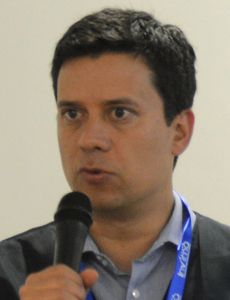Colombia: Portage to Latin America?
Pharmaceutical Executive
Senior Editor Casey McDonald visits with industry and regulatory officials in Bogotá to discuss colombia’s strategy for growing its life sciences enterprise, and whether it can be a stable force amid the region’s historically challenging macroeconomic and political fluctuations.
The hit show Narcos, which follows the epic rise and fall of drug kingpin Pablo Escobar, is both a blessing and a curse for Colombia, my guide tells me. Like Sopranos immortalizing negative Italian mafia stereotypes, Narcos once again reminds the viewer of the country’s corrupt and violent past. The idea of Medellín or Bogotá as dangerous destinations for business or leisure is alive and well.
The pros of crafting and publicizing the show include, of course, exposure for the country and additional industry with film crews and production budgets going towards the nation’s economy. But perhaps more importantly, my guide explains, the show and the financial investments that have made it possible may represent a bigger story of the country’s new vibrancy. Netflix has partnered with Telemundo on production of the show, a move that could position the Internet streaming service to do further work in Colombia and the region. It’s one thing when members of established industries like oil and mining firms set foot in an emerging country, but for an entrepreneurial, disruptive tech entity like Netflix to show interest, as a vote of confidence, this is an entirely different piece of exposition to the nation’s economic narrative.
Perhaps the entertainment and biopharma industries agree on the potential of the emerging Latin American market. A swelling population with a growing middle class will have cash to spend, be it on their healthcare or on streaming videos. Certainly, the conservative, lumbering life sciences industry should take notice of the hip, nimble Netflix as it positions itself on the continent.
Port of call
As an entry port to Latin America from North America, Europe, or Asia, Colombia’s geographical positioning makes clear sense for accessing a region that seems remote and exotic. Its Northern Hemisphere positioning gives foreign companies a central hub with spokes to the rest of the region. A flight time of around five hours to Mexico City and Sao Paulo, or to New York, illustrates this convenient arrangement. And for bulk shipping, its setup with ports on the Caribbean and the Pacific are a clear advantage over the rest of the continent.
As other countries with economic development in mind, the government seems more than willing to roll out the yellow, blue, and red carpet for modern industry. Enticements like free trade zones, duty free importation of machinery and raw materials, income tax deductions, and job creation incentives would be well received by any CFO or accountant walking the international floor at the yearly BIO convention.
In addition to geographic factors and business-friendly tax arrangements, Colombia boasts economic figures and historical trend lines that place it on par with, or above its neighbors. A problem with trying to grow a business in emerging markets is that they are not always emerging; they can stagnate and even retract. Data from 2014 for Colombia appears to indicate strengths like stout GDP growth of 4.6%, leveling inflation at 3.66%,

and declining unemployment of 9.1%, with these numbers showing relatively sturdy improvements for the last decade plus (regional economic figures courtesy of Invest in Bogotá). Some countries in the region like Peru, Mexico, and Chile share this optimistic outlook while the other key nations, by size and influence-Brazil, Argentina, and Venezuela-have given the continent a bad name in recent years with negligible and negative growth values. Notably, while Venezuela appears to be a long way from a turnaround, recent Argentinian elections turning away from pink populism with the selection of Mauricio Macri, who ran a pro-business center-right campaign, could be a larger positive indicator for industry in the Southern Hemisphere.
Perhaps the nation’s most telling statistics come from a demographics analysis. Colombia’s population, third largest in the region after Brazil and Mexico, is younger than much of the developed world, with 55% under 30 years of age. The growth of the country’s middle class, also mirrored somewhat in neighbors Peru, Chile, and Mexico, could be the key signal for an industry that needs a populace with purchasing power. The rising middle class has seen impressive growth from 16% of the populace to close to 30% from 2002 to 2014, while the percentage qualified as living in poverty and extreme poverty has dropped from close to 50% to 30% and 18% to under 9%, respectively, in that time period.
More specific to those in the biopharma industry, Latin America and the Caribbean, as a region, have seen growth in healthcare expenditure, total, and per capita, at rates that are close to double that of the rest of the world over the last five years. Total healthcare expenditure in the region grew at a 9.5% CAGR, compared to 5.3% in the rest of the world, and per capita spending grew at 8.1% CAGR regionally compared to 4.1% globally. While Colombia ranks below average for the region, in terms of per capita spending on healthcare, the country ranks fourth for total healthcare expenditure, trailing Brazil, Mexico, and Argentina, and the amount spent per person will grow substantially in the coming years.
Big players are in
Witnessing the positive trends depicted in these numbers, one company established and growing in Colombia and the rest of the region is Sanofi. Counting all business, including units such as animal health, Sanofi is the top life sciences firm in the region, according to Mauricio Botero Caicedo, Sanofi’s Colombia general director. The French multinational has a headcount that exceeds 1,700 in the country, including an industrial workforce and sales professionals.
The company foresees growth as it plans major launches to hit the market in the next two years for its insulin glargine product, Toujeo, and controversial cholesterol-lowering therapy, Praluent. Sanofi already has a strong presence in the insulin market as well as in cardiovascular and oncology.
Sanofi also has a major investment in its dengue fever vaccine trial that is in the process of filing for approval. The vaccine is a necessity for the nation, which contributed half of the patients for the clinical trial-10,000 patients-with the other 10,000 coming from Brazil and other nations. There is a strong environment in Colombia for running clinical trials with good institutions and researchers, noted Botero Caicedo.
The company saw challenges in 2014, with price controls hitting key products, but in 2015 Sanofi is back to double-digit growth in a market predominantly seeing single-digit growth. Moving forward with the pricing issue, the government has implemented a good, objective methodology regarding price determination. When it proposed price decreases, industry members were able to work with government to form an acceptable decree, Botero Caicedo said.
In contrast to Sanofi, which is established and growing both via acquisition and organically, Indian pharmaceutical giant Cipla is established in Latin America and the Caribbean through partnerships. The firm has been in Latin America for about 15 years and markets hundreds of products through part- nerships, and is expanding its overall presence.
Cipla currently plans to expand its operations in Colombia and will begin establishing a regional hub there in 2016. Asked why now, after 15 years of selling its products through partners, does Cipla plan to make its presence and name known, Raman Wattamwar, country manager, said, “We have been present for some time, and we know the market. The economy is doing well and growing steadily. Regulatory pathways are defined, hence it’s good time to expand our presence by our own operations and through partners to take maximum advantage of opportunities in the Colombian market.”
Cipla will operate in institution and private market segments, with its philosophy of “none shall be denied” by providing quality and affordable products. Wattamwar added that compared to other countries, setting up a business in Colombia is fairly straightforward, and government policies are supportive.
Importantly, Cipla will be able to take advantage of institutional selling in the country by attacking the market with a bulk mindset. And the lack of barriers to foreign companies competing with local firms for contracts makes this a realistic endeavor. Cipla’s goal is to be embraced as a local company.
Access as a right
Colombia is in a transition period from the regulatory standpoint, explained Dr. Javier Guzmán Cruz, director of the country’s regulatory body INVIMA. With the mandate to move towards better quality, equity, and financial sustainability now that Colombia has achieved universal
Guzmán Cruz

healthcare coverage, the government must deal with the problems of being a middle-income country. This means Colombia has many of the pressures of higher-income nations while not possessing the same spending power, Guzmán Cruz said. The country has legislated that healthcare is a fundamental human right for its citizens; couple this demand with the strain of a rising middle class and increasing life expectancy, there is substantial strain on the system, with a great challenge of granting its citizens with appropriate access to drugs.
Historically, accessing drugs in the Colombian healthcare system depended on an out-of-date health benefits package, which led to the rise of a legal practice known as tutela, an instrument by which citizens have access to judges. The system led to rapid decisions with no consideration of the health benefit assessment of the drug, said Guzmán Cruz. This practice, coupled with a free market where prices were set by supply and demand, led to abuses and drugs with prices higher than in other nations.
The response to the challenges the country is facing will be a very innovative one, Guzmán Cruz explained. The Colombian government will integrate approval, health technology assessment, and price regulation simultaneously. New technologies that come to the Colombian market will have to have assessment and pricing decided alongside the marketing approval, he noted.
Illustrating the challenges facing Colombia is the same revolutionary drug launch that turned the US healthcare system, and the rest of the world, on its head. In response to Sovaldi and the rest of the hepatitis C curative treatments, “our alarms went off,” said Guzmán Cruz. The prospect of treating a country with an estimated 350,000 infected individuals would have been a steep bill that could have bankrupted the system. However, the financial burden hasn’t materialized yet because so many infected people are not diagnosed, he noted.
The INVIMA director expects the hepatitis C market to be a competitive one by next year as two new drugs will be registered in the first quarter. Diagnosing and treating the large patient population will take time.
Will science take root?
Colombia’s human resources are a draw to bringing business to the nation, company officials explained to Pharm Exec. A young, well-educated workforce is another strength for the country, emphasized by the regional development

office for attracting industry. But while the potential personnel may support marketing and administrative functions, Colombia is lacking in scientifically trained workers.
While the government in Colombia is making an effort to incentivize and stimulate the country’s standing as a hub for science and technology, company and government officials agree that innovation is currently not part of the country’s genetic makeup.
A central driver in Colombia’s growing healthcare system, and an expanding drug marketplace, is the evolution of healthcare as a fundamental right to its citizens. The predictable question will be whether an expanding market that hopes to embrace novel technologies from outside, can also encourage a culture of innovation inside the country. But an increasingly socialized approach to meet the needs of the recipients of new therapies could take Colombia further away from the profit-driven life science innovation hubs, like those on the East and West coasts of the US.
Casey McDonald is Pharm Exec’s Senior Editor. He can be reached at cmcdonald@advanstar.com
